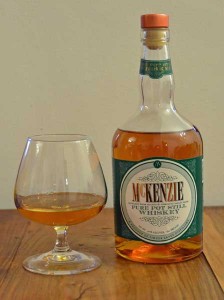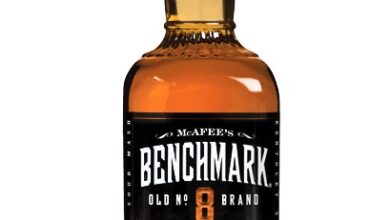McKenzie Pure Pot Still Whiskey Review
By Richard Thomas
Rating: B-

from Finger Lakes Distillery
(Credit: Richard Thomas)
Another expression from those busy people at Finger Lakes Distilling in upstate New York, McKenzie Pure Pot Still Whiskey is their spin on the Irish style. American single malts and Irish-inspired whiskeys are a niche market in the United States, but certainly a growing one. The operative question for a whiskey lover interested in these whiskeys is “are they a good substitute for my favorite Irish whiskey or scotch?” Of course, there are as many answers to that question as there are scotches and Irish whiskeys, but one useful thing is to compare something like McKenzie Pure Pot Still to its counterparts across the Atlantic.
First off, unless the Irish whiskey in question says “Malt” on the label, it’s a blend of malted and unmalted barley (grain) whiskeys, and so is McKenzie Pure Pot Still. In fact, even though the Irish are famed for pot stills, most Irish blends have at least a proportion of non-pot distilled whiskey, whereas this stuff is all pot distilled. Following the local food attitude that infuses so much of what Finger Lakes does, the grain for their Pure Pot Still comes from area farmers.
One feature that separates the McKenzie Pure Pot Still from other American malts and blends is the aging. Instead of aging in charred new oak, as is usually the case for just about every whiskey made in America, this Finger Lakes whiskey recycles the distillery’s own ex-bourbon and -rye barrels. Since almost all Irish whiskey is matured in used casks of one sort or another, this puts Pure Pot Still much closer to its Irish roots than most other American whiskeys of this type.
Whereas almost all Irish whiskeys are triple distilled, McKenzie Pure Pot Still is double distilled (and thus like virtually all other whiskeys that aren’t Irish). Finger Lakes chose to do it this way to “keep more flavor in the whiskey,” and I think they made the right decision there, and pretty much straight on down the line.
The Whiskey
McKenzie Pure Pot Still Whiskey has no additives, is not chill-filtered, and comes bottled at 40% abv. Although the label bears no aging statement, the constituent whiskeys in the blend are aged for a little over two years. The packaging is typical of the McKenzie line: a fat, pot still-shaped clear glass bottle with a label design reminiscent of an Old West saloon, and topped by a plastic, copper-colored stopper with an artificial cork.
In the glass, the whiskey has clear pale gold coloring. Taking in the nose, I found it oddly crisp and leathery at the same time, the former coming from the coppery tinge. There is a sweet apples and pears side to the scent, along with a slight oaky note.
On the palate, the whiskey has a lovely, silky texture. It has that malty, grainy kind of sweetness (not so apple-ish anymore), along with notes of caramel and oak, and sometimes I thought just a bit of fresh pine as well. The finish starts from the neutral, silky texture of the whiskey, taking its time and trailing off into a moderate, slightly peppery warmth.
Finger Lakes bills this whiskey as “a richer version of the commercial Irish whiskies on the market. It’s full of flavor, but smooth as silk stockings.” I agree for the most part, particularly about the silky aspect. I found it surprisingly complex for a two year old, so don’t let its youth throw you. It’s as good or better than a lot of the 10 and 12 year olds coming out of Ireland, and something I would recommend to any serious Irish whiskey fan in the States.
The Price
McKenzie Pure Pot Still Whiskey typically retails for $39.99.




I think the author has become a bit confused, lacking the knowledge in this area!
A blend is never a Pure Pot Still, or Single Pot Still as Irish Distillers are now calling it as the U.S. would not let them use the historic term for bottles sold in the US. A blend is a mix of either a single malt (made from malted barley, in pot stills, in a single distillery) or Pure Pot Still (made by malted barley, with the addition of a percentage of U malted barley, which increases the spicy notes, oiliness, heaviness etc, in pot stills at a single distillery and grain alcohol made in a Coffee Still or Continuous Still from a mash ill in Scotland that is mostly corn and in Ireland one that is mostly wheat, though mash ills change over time due to the cheapness of grains. The continuous still is a far cheaper and quicker way of mass producing cheap spirit though it lacks in charachter, taste and complexity, thus better blends have 40-60% of the pot still produced spirits made of barley. The Coffee Still was invented in the mid 19thC and was widely adopted inScotland. Until the recent few decades all Scotch was blended whiskey, hence it won the retail war, being far cheaper. Irish distilleries rejected these stills outright, and continued to produce only high quality Single Malts and Pure Pot Stills in pure iterations, though in 1968, the Irish distillers, facing financial ruin, mostly amalgamated into one company and switched most of their brands (Jameson, Paddy, Powers). Crested Ten) from Pure Pot Stills to blended whiskey in order to compete with cheap Scotch. Redbreast and Green Spot continued on as the sole survivors of that unique Irish style of whiskey that is Pure Pot Still. The others were all marketed as blends, they were never Pure Pot Stills and never could be as they were adulterated with grain whisky which means it is mostly a corn, wheat or cheap grain mash, made in a Coffee or Continuous Still.
Irish Whisky cannot be released at under 3 years under the term whisky.
I would suggest tasting it against any of the following Pure Pot Still / Single Pot Stills to compare the style All are Irish
Green Spot, Redbreast 12 year old, Redbreast 12 year old cask strength, Redbreast 15 year old, Redbreast 21 year old, Redbreast Mano a Lamh, Green Spot Barton, Yellow Spot, Powers John Lane, Powers Signature, Powers Three Swallows, Jameson 15 year old limited once off bottling, Dungourney, Midleton 25 year old, Midleton 26 year old, Midleton 30 year old, Paddy Centenary Edition or some of the old pre 1968 bottlings or defunct distilleries old bottlings that you may find at auctions that state Pure Pot Still on the bottle.
A double Distilled pure pot still defies convention and wisdom and so should be one to watch as it reaches a more mature age, most pure pot stills having been triple Distilled. However single malts from Cooley (ie Tyrconnel Single Malt, Connemara Single Malt, Kilbeggan Bend, etc etc and Teeling releases so far (e Teelings Single Malt, Teelings Single Grain and Teelings Blend etc) and others are all double Distilled and Irish. Whilst Bushmills Single Malts, Black Bush, Jameson, Midleton Very Rare, Crested Ten, Powers, Paddy etc are triple Distilled
Oh, look. Yet another US distiller attempting to trade off the good reputation of Irish whiskey. Other reviews of this substance consider it to be extremely sub-par, so I find the impartiality of this review to be suspect.
Oh look. Yet another clueless, snowflake jackass on trolling the internet, looking for something to trigger his outrage. Your intelligence is suspect